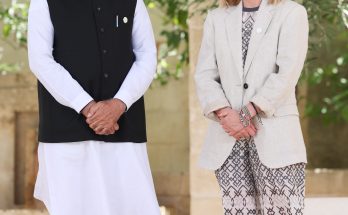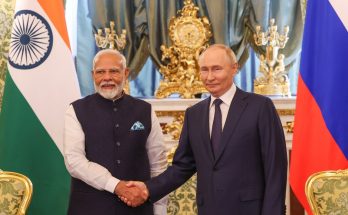
The long-dreamt “Ram Rajya” acquired life-force as Prime Minister Narendra Modi performed the “pran-pratishtha” ceremony at the idol of Lord Ram and unveiled a vision of a faith-fuelled India, which will fuse “deva (god) with desh (country) and Ram with Rashtra.”
It was a carnival of faith, fervour and festivity as millions of Hindu devotees across India and the world celebrated the homecoming of Lord Ram. At 12.20 pm sharp on January 22, the 73-year-old Indian leader performed the “pran-pratishta” consecration ceremony amid Vedic chants at the newly-built temple consecrated to Lord Ram in the ancient city of Ayodhya. With this ceremony, broadcast live to millions of Indians who bore witness to this historic moment, the 51-inch statue of Ram, installed at the sanctum sanctorum of Shri Ram Janmaboomi Temple in in Ayodhya, has become the living deity.
With the world watching, Prime Minister Narendra Modi, who led the consecration ceremony, announced in an emotion-choked voice that “Ram has come home.” “”Lord Ram has finally arrived (in his abode) following the wait of centuries. After the patience that we showed for centuries and the sacrifices we made, our Lord Ram has finally arrived.”
Modi’s speech was greeted with rapturous chants of Ram and cheered by sadhus, seers socialites, film starts and business tycoons who were among the chosen few invited to witness this sacred ceremony in Ayodhya. The who’s who of India’s power list turned up in full regalia to bear witness to this iconic moment in the country’s history.
A New Time Cycle
“Our Ramlalla will no longer live in a tent. Our Ramlalla will now live in this divine temple,” he announced like a sage.
Linking the inauguration of the Ram temple with national renaissance, Modi said: “January 22, 2024, is not a date on a calendar. This is the origin of a new time cycle. A nation rising up after breaking the mentality of slavery, a nation taking courage from every bit of the past, creates history in this way.”
“A thousand years from now, people will talk about this date, this moment. These are indelible memory lines being inscribed on the wheel of time.”
Modi projected the Ram temple as an emblem of India’s culture and a symbol of the country’s development aspirations. “This is India’s time, and India is now moving forward. We have reached here after centuries of waiting. We all have been waiting for this era, this period of time. Now, we will not stop. We will reach the heights of development,” he said.
The entire country celebrated the homecoming of Ram by lighting lamps and singing devotional songs, reminiscent of the annual festival of Deepavali. After the Ram temple “Pran Pratishtha,” Saryu Ghat in Ayodhya was illuminated with hundreds of thousands of diyas. Many state governments, organizations, and even private businesses declared holidays or partially closed to commemorate this occasion, enabling people to take part in the festivities.
(Juhi Sharma contributed inputs for this article)
Author Profile

- Manish Chand is Founder-CEO and Editor-in-Chief of India Writes Network (www.indiawrites.org) and India and World, a pioneering magazine focused on international affairs. He is CEO/Director of TGII Media Private Limited, an India-based media, publishing, research and consultancy company.
Latest entries
 India and the WorldJuly 9, 2024Defying West, India sets $100 billion trade target with Russia
India and the WorldJuly 9, 2024Defying West, India sets $100 billion trade target with Russia India and the WorldJuly 5, 2024India at SCO: Takes swipe at Pakistan for cross-border terror, pushes alternative to BRI
India and the WorldJuly 5, 2024India at SCO: Takes swipe at Pakistan for cross-border terror, pushes alternative to BRI India and the WorldJune 14, 2024Modi’s Day 1 in Italy: Bonding with Britain, France
India and the WorldJune 14, 2024Modi’s Day 1 in Italy: Bonding with Britain, France India and the WorldJune 13, 2024G7 summit in Italy: Modi to showcase India as leader of Global South
India and the WorldJune 13, 2024G7 summit in Italy: Modi to showcase India as leader of Global South






